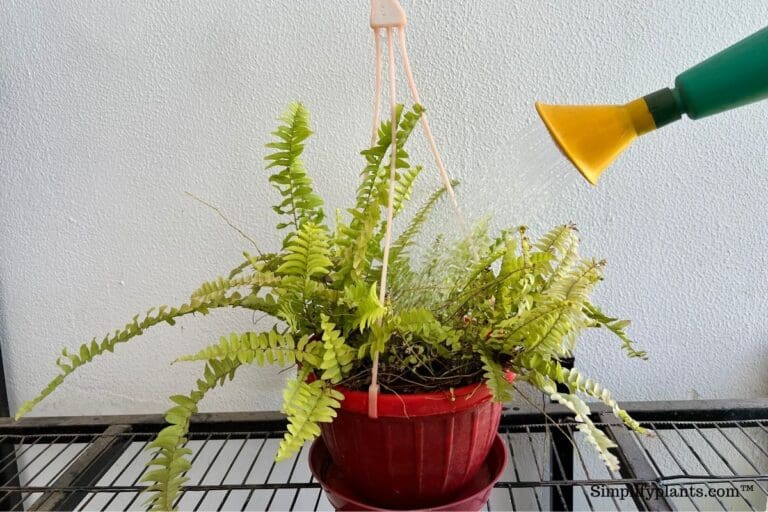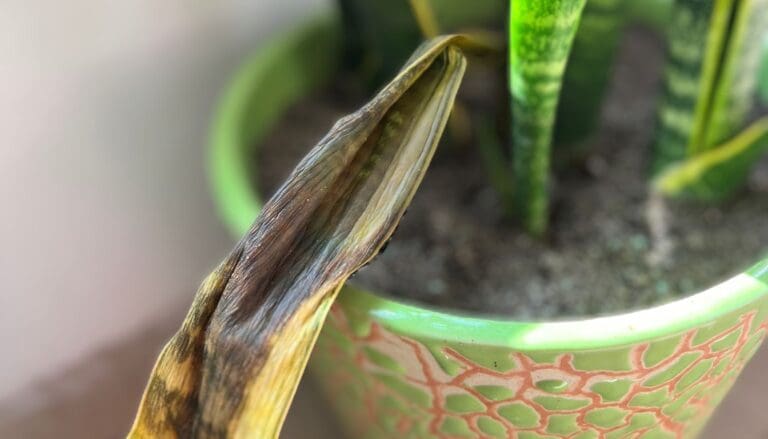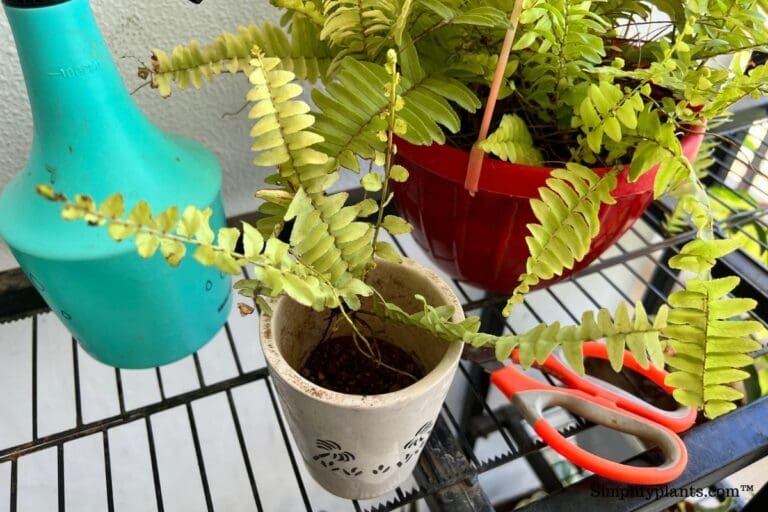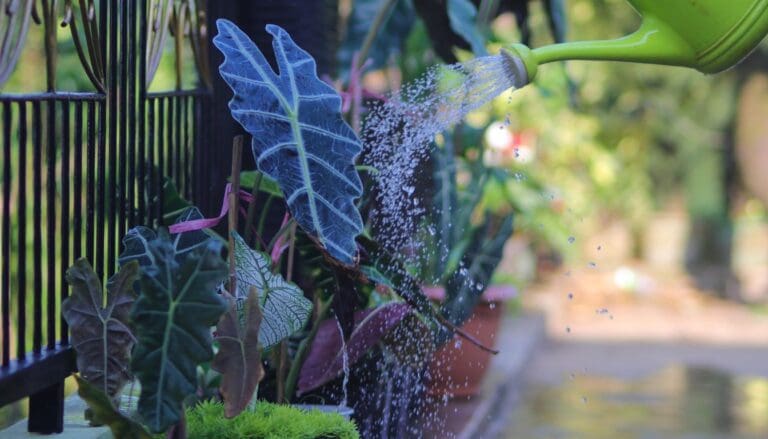How To Save A Dying Jade Plant? (Signs, Solution & Prevention)
Jade plants are adaptive and resilient in nature, but they are likely to suffer when they are kept in extreme situations for an extended period.
Some common signs of a dying jade plant are yellow leaves, wilted leaves, dropping leaves, and wilting of the foliage. If you notice any of these signs, you must act quickly to save your jade plants from dying.
Water your jade plant when the soil gets dry and provide them with an ample amount of sunlight to keep them thriving. Please keep them in a ventilated spot with low humidity and mist some neem oil occasionally. Providing proper care and maintaining a healthy environment can help save a dying jade plant.
Identifying the problem and taking the necessary steps to revive your plants is crucial for saving your jade plants.
Let us dive right into it so that you can spot the exact problem in your jade plant and save them from dying.

Please note: Simplify Plants is reader-supported. Some links in the post are affiliate links and I get a commission from purchases made through links in the post.
Signs of dying jade plant
Plants cannot speak, but they give signals through different signs to show they are unhappy. The problem could be anything, but the signs the plant gives are certain. Some of the common signs of a dying jade plant are:
- Wilting leaves
- Drooping leaves
- Yellow leaves
- Black/brown spots on leaves
- Leggy growth
- Brown leaves
- White spots on leaves
- Leaves falling off
If you see any of these signs, you need to carefully examine your plants and take appropriate steps to save your plants from dying.
How do I bring my jade plant back to life?
Knowing the problem is the foremost part of reviving any plant. To treat your jade plant, you must know what is bothering them.
In this article, we have discussed all the possible problems that your jade plant may have, and we have also discussed possible solutions for the same.
Overwatered jade plant

Overwatering is the most common reason for your jade plant’s ill health, and most beginners end up wilting their plants as they overwater them.
Planters often overwater their jade plant, assuming it will boost their growth. But, unfortunately, they are ignoring the soil condition and watering the plant, leaving the soil soggy all the time.
The overwatered jade plant goes through many problems, and you need to fix these problems asap, else your jade plant is likely to die.
Signs:
- Yellow leaves
- Brown leaves
- Root rot
- Stunted growth
- Leaves falling off
Solutions:
We can fix our overwatered jade plant in the following ways:
- Firstly stop watering your jade plant and let it dry out completely.
- Prune the damaged parts of the plant.
- Check if the pot has a proper drainage system or not, it might be the root cause of overwatering.
- Keep the plant in a good air circulated space and make sure the soil is well-draining.
- Provide proper lighting to the plant to dry quickly and avoid staying wet for longer periods. You can grow lights too if natural light is not sufficient.
Prevention:
- Always wait for the soil to dry out completely before you decide to water them.
- Soak your jade plant or water thoroughly and let the excess water drain out. The excess water should drain out within 2 minutes of watering if the drainage system is proper.
- If you have a tray under the pot, then empty it every time you water the plant.
- Follow the rule of watering adequately but less frequently to avoid wet conditions.
- Check the soil by using your finger and scratching the soil up to 2 -3 inches. Take out the finger; if the soil is sticking to the finger or feels moist, then hold on to watering till it gets completely dry.
- If ever in doubt, avoid watering and wait for a few days rather than keeping the soil wet.
- You can also use a moisture meter to check the soil conditions before watering.
Also read: How often should I water my jade plants?
Under Watered jade plant

When under-watered, jade plants will face problems that may affect their growth.
The soil will feel dry to touch, and the entire plant will look dull. The plant is lacking water and nutrients, which can lead to several problems.
Signs:
- Brown edges
- Falling leaves
- Stunted growth
- Curling leaves
Solutions:
- Fixing underwatered plants is an easy job but should be done correctly.
- Prune the damaged leaves.
- Soak the jade plant in water for some time or water them thoroughly till the excess water comes out.
- You can water them next when the soil is halfway dry to avoid under watered conditions.
Prevention:
- When the soil is dry, water your jade plant and do not let the soil lose its moisture completely.
- Drooping and shriveling leaves are initial signs of dehydration. Consider it as a signal of watering them.
- Always check the soil before watering them and keep a check on the soil every 4-5 days.
- Avoid following any routine blindly, as suggested by many. Always watch your plant and give water as per their needs.
Also read: Overwatering vs. Underwatering
Root rot

Root rot is a manifestation of an overwatered jade plant, and it progresses if the soil is continuously staying wet.
If ignored, roots will be damaged permanently, and there will be no going back. Therefore, treating root rot on time is very important to revive your plant to life.
Signs:
- Yellow foliage
- Brown leaves
- Wilting leaves
- Stunted growth
- Brown and mushy roots
- Foul odor from roots
- Thin stems
Solutions:
- Start with taking your jade plant out of the pot gently to check the condition of the roots.
- If the roots are brown and mushy, prune them without damaging the healthy roots.
- Sterilize the tools before and after pruning.
- Wash the roots with bleach and then plain water and let the roots and plant air dry for a day. It will also help to get rid of the bacteria.
- Now repot the plant in a new pot with a proper drainage system.
- Use a fresh, well-draining potting medium to repot your plant and avoid watering the plant for some time.
- Water after a few days, let the excess water drain out completely, and keep your plant in good lighting.
Prevention:
- Water your jade plant only when the soil is fully dry. Excess watering supports root rot conditions.
- Check the soil before watering the plant, even if you follow the suitable watering regime.
- Ensure the pot has enough drainage holes to allow excess water to flow out and never keep the soil moist for too long.
- Soil characteristics also play an essential role in this. The soil should be suitable for your jade plant.
- Keep your plant in proper lighting and well-ventilated space.
Also read: How to fix root rot in a jade plant?
Lighting issues

Keeping jade plants in the wrong lighting conditions will also kill them. However, they will thrive in bright light and are flexible with other conditions too.
But if consistently kept in unfavorable conditions, the plant’s growth and development are compromised.
Signs:
Jade plants can be adversely affected if not kept in proper lighting, and it can be too much light or poor lighting.
Too much light:
- Sunburn
- Brown spots
Too less light:
- Leggy growth
- Brown leaves
- Slow growth
- Yellow leaves
Solutions:
We will go through the solutions to save your plant from too much light and low light and choose the right spot for them. Balance is the key to keep your plants thriving!
Too much light:
- Prune the damaged leaves and move your plant to a sunny location where it gets lots of indirect sunlight.
- If the plant is outdoors, cast a shade over them or move them to a shaded area to protect them from harsh light.
- If the plant is placed near a window, move it a few feet away or use a sheer curtain to cover the window, which will help filter the direct light.
Too less light:
- Move your plant to better lighting so that your jade plant can receive ample light.
- If you lack natural light indoors, you can move your plant outdoors to improve the lighting conditions but avoid direct light on your plants.
- You can use an artificial light source to fulfill your jade plant’s light needs.
- Rotate the plant so that all parts of the plant get even light.
Prevention:
- Jade plants love good lighting and need brightly lit locations to thrive. Giving the plant 6-8 hours of indirect light and 1-2 hours of soft direct light is best.
- Keep them near a window with morning and afternoon light, or somewhere it can get sufficient ideal light.
- Always move your plant gradually to different lighting to save them from shock.
Also read: How much light do jade plant need?
Temperature fluctuations

Jade plants are adaptable in nature, and thus they can adapt to a variety of conditions.
Though frequently moving them from one condition to another can stress them. Your plants may face several issues, which need to be fixed.
Signs:
- Discolored leaves
- Stressed plant
- Wrinkled leaves
- Stunted growth
- Brown spots on leaves
Solutions:
- Keep the jade plant in consistent conditions and avoid keeping them in temperature below 40°F.
- If there are any damaged parts, prune them off.
- During freezing temperatures, you can keep your jade plant a few feet away from a furnace to keep them warm.
Prevention:
- Keep jade plants at temperature levels between 65°F-85°F though they can tolerate temperatures as low as 40°F.
- Keep your plant away from heating systems such as furnaces, radiators, vents, etc.
- Move them indoors during winters, and also protect them from cold drafts.
- Keep your plants away from the window during winters; keep them at a distance.
Also read: Should I move my jade plant outdoors?
High humidity

Jade plants are accustomed to dry environments which might not be the case for every grower.
Usually, homes have medium-high humidity levels, and if jade plants are kept with other indoor plants, it adds to the humidity.
That may become a problem for your jade plant. In addition, high humidity often leads to fungal infection and other problems in a jade plant.
Signs:
- Leaf spot
- Fungal diseases
- Yellow leaves
- Brown spots on leaves
Solutions:
- Maintain ideal humidity around the jade plant, preferably between 30-50 %. Though, a slight variation will not harm them.
- You can keep your plant away from humidity-loving plants and move to a better lit space to keep the space less humid around them.
Prevention:
- Keep your jade plant in a location with low humidity or maintain low humidity around them. Space with good airflow is ideal for them.
- Do not mist them and avoid keeping them together with other plants.
- Please do not keep them in the bathroom, near an aquarium, or any such space with high humidity.
- You can use a dehumidifier to maintain ideal humidity around them, especially if there is consistently high humidity in your region.
Also read: Should I mist my jade plant?
Pest infestation

Pest infestation is very disturbing for any plant, as it makes the plant weak and dull.
Pests such as mealybugs, spider mites, and aphids commonly infest the jade plants.
They suck the sap of the plant and lead to several issues. As the situation progresses, the plant may even die without treatment.
Signs:
- Weak plant
- Yellow leaves
- Brown spots
- Leaves falling off
- Stunted growth
Solutions:
- Immediately move your jade plant in an isolated area, away from other plants.
- Prune the damaged parts. It will also help the plant get rid of a lot of pests. Dispose of the damaged parts immediately.
- Wash the plant with soapy water thoroughly and then with plain water. It will remove a lot of pests.
- You can use a neem oil spray by mixing 2 tsp neem oil with 1 gallon of water and pouring it in a spray bottle. Spray it all over the plants and repeat every 1-2 days to eradicate the pests completely.
- You can also opt for chemical pesticides readily available in the market. Use them according to the instructions given on the package.
- Keep your plant in good air circulation and dry area. This will help kill the plants.
- When all the pests have been removed, repot the plant in a fresh soil mix.
- Disinfect the area where you were treating your pest-infested jade plant after the treatment.
Prevention:
- Keep the jade plant’s soil dry to avoid root rot conditions.
- Maintaining low humidity and an arid environment around them will reduce the chances of pest attack.
- Keep the plant in check every few days or whenever you water them. This will help you to know if your plant is healthy or not.
- When buying a new plant, always keep it in isolation until you are sure that it is completely healthy.
- You can use neem oil solution on your plant every month as a proactive measure to keep pests at bay.
Also read: How to get rid of bugs on a jade plant?
Inadequate Fertilization

Jade plants are known to be light feeders, due to which many planters ignore their fertilizer needs. As a result, the soil may lose its nutrients which will hamper the health and growth of the plant.
If the plant is not fed appropriately, it may face problems that can even lead to its death.
Signs:
- Weak plant
- Yellow leaves
- Droopy leaves
Solutions:
- Feed your jade plant with high nitrogen or a balanced fertilizer to give them a boost of nutrients.
- Always water your plant before feeding them to allow the nutrients to distribute evenly in the soil.
- Fertilize the plant every 1.5-2 months but only during the growing season.
- If you feel your jade plant lacks nutrients and it is dormant season, then wait for the spring season to feed them.
Prevention:
- You can prevent under-fertilization of the plants by fertilizing them with high nitrogen fertilizer in the growing season.
- Do not fertilize them in the dormant season as they rest during this time.
- Give them enough light to allow the nutrients to break down and give the plants the required energy to grow and develop.
Also read: How often should I fertilize my jade plant?
Final Words
Jade plants are resilient and adaptable succulents, loved by many planters. They will survive in almost all conditions.
If you want your plant to remain healthy, you need to keep them in conditions that imitate their native environment.
Keep the atmosphere warm and dry around them. Avoid misting as it will add to the humidity.
Water your jade plant with chlorine-free water. Water on the soil and not leaves, as wet foliage leads to fungal growth.
Please provide them with ample light. A mixture of indirect and direct light keeps the jade plant thriving. Direct light should not be too harsh, though.
Fertilize the plant only during the growing season with a nitrogen-rich or balanced fertilizer.
Use neem oil spray as a protective measure. It will keep the pests at bay and kill the pests and eggs in contact, if any.
We suggest pruning the jade plant when it gets too bushy, especially during the early spring. It helps them grow new leaves in the growing season.
Source: NYBG, The University of Arkansas, University of Florida, Phytochemical and Antimicrobial Activity of Jade Plant, CABI, University of Minnesota, The University of Missouri.
Recommended Garden Supplies
| Product Image | Our Recommended Gardening Supplies | Check Offers! |
|---|---|---|
Top Top
Top
Top
Top
Top
Top
Top
Top | rePotme Houseplant and Tropical Classic Potting Soil Mix | Check Offer On Amazon |
 Top
Top
Top
Top
Top
Top
Top
Top | Espoma Organic Indoor Plant Food | Check Offer On Amazon |
 Top
Top
Top
Top
Top
Top
Top
Top | GooingTop LED Grow Light 6000K Full Spectrum Clip Plant Growing Lamp | Check Offer On Amazon |
 Top
Top
Top
Top
Top
Top
Top
Top | Soil Moisture Meter | Check Offer On Amazon |
 Top
Top
Top
Top
Top
Top
Top
Top | Govee Hygrometer Thermometer, Bluetooth Enabled! | Check Offer On Amazon |
 Top
Top | LEVOIT Humidifiers for Large Room(Best For Plants) | Check Offer On Amazon |
 Top
Top
Top
Top
Top
Top
Top
Top | Upgraded DIY Automatic Drip Irrigation Kit, 15 Potted Houseplants Support | Check Offer On Amazon |
 Top
Top
Top
Top
Top
Top
Top
Top | Stainless Steel Heavy Duty Gardening Tool Set | Check Offer On Amazon |
 Top
Top
Top
Top
Top
Top
Top
Top | Bonide Insecticidal Soap | Check Offer On Amazon |
 Top
Top
Top
Top
Top
Top
Top
Top | Bonide 32 oz Spray Neem Oil for Organic Gardening | Check Offer On Amazon |
 Top
Top
Top
Top
Top
Top
Top
Top | Garden Safe Fungicide | Check Offer On Amazon |






